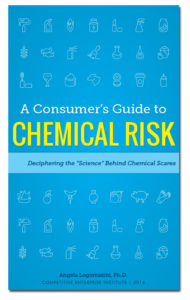Many research studies condemn chemical products by asserting they are “linked to” various health ailments. But this phrase simply means that a researcher found some statistical association, which does not prove causation and is not considered particularly important if the relative risk ratio is low. For example, in 2010 numerous headlines touted a study that claimed that breast cancer is “linked to” synthetic fibers(1)—“Chemical Exposure Could Triple Breast Cancer Risk,”(2) “Study Links Chemical Exposure to Breast Cancer,”(3) and “Chemical Exposure: Science Takes it Seriously Where Breast Cancer Is Concerned.”(4)
Reuters reported:
In a study in Occupational and Environmental Medicine, a British Medical Journal title, the researchers found that women exposed to synthetic fibers and petrol products during the course of their work appeared to be most at risk.
“Occupational exposure to acrylic and nylon fibers, and to polycyclic aromatic hydrocarbons may increase the risk of developing postmenopausal breast cancer,” they wrote. But some experts commenting on the study expressed caution, saying such links can crop up by chance. “In a study of this sort positive associations often occur simply by chance,” said David Coggon, a professor of occupational and environmental medicine at Britain’s Southampton University. “They carry little weight in the absence of stronger supportive evidence from other research.”
The Canadian scientists conceded their findings could be due to chance, but also said they were consistent with the theory that breast tissue is more sensitive to harmful chemicals if the exposure occurs when breast cells are still active — in other words, before a woman reaches her 40s.(5)
As the Reuters story’s one critic points out, a relative risk level of 3 (three times more likely) is not particularly strong as has a high probability of being merely accidental. The Canadian researchers basically admit that reality but then move on to rationalize their claims with yet another tricky phrase: Their findings are “consistent with” a theory about breast cancer tissue being sensitive to the chemicals. The authors are mincing words to increase confusion about the study result, which merely reports a weak association that is at best consistent with a mere theory.
Browse the terms on the sidebar of this webpage for more details and/or download a copy of A Consumer’s Guide to Chemical Risk: Deciphering the “Science” Behind Chemical Scares.
(1) France Labrèche et al., “Postmenopausal Breast Cancer and Occupational Exposures,” Occupational and Environmental Medicine 67, no. 4 (April 2010): 263-269.
(2) “Study: Chemical Exposure Could Triple Breast Cancer Risk,” FOX News, April 01, 2010.
(3) Kate Kelland, “Study Links Chemical Exposure to Breast Cancer,” Reuters, April 1, 2010.
(4) Britta Aragon, “Chemical Exposure: Science Takes it Seriously Where Breast Cancer Is Concerned,” Cinco Vidas Blog, September 29, 2010.
(5) Kelland, “Study Links Chemical Exposure to Breast Cancer.”



[…] operative phrase here is “linked to,” which is one of several terms that greens use to exaggerate the meaning of studies reporting […]